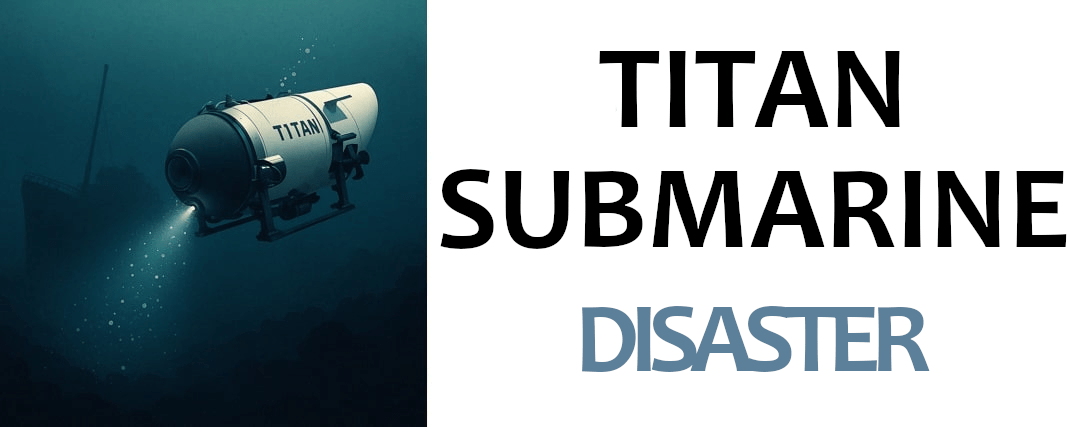Table of Contents
- 🚢 A Submarine Bound for History
- 👥 The Passengers of the Titan
- 🌫️ A Sudden Disappearance
- 💥 Understanding the Implosion
- 💔 Global Reactions
- 🛳️ Why Titanic Still Captivates
- 💙 The Heart of the Ocean – A Lasting Symbol
- 🌊 The Dream of Exploration vs. the Reality of Risk
- 📖 Lessons from the Tragedy
- 🌌 A Timeless Fascination with the Abyss
- 📜 A Story that Transcends Time
- 💎 Jewelry as an Emotional Link
- 📰 Media and Social Network Response
- 🏛️ Reactions from Families and Institutions
- 🧭 A New Form of Tourism?
- ⭐ Why This Story Matters
- ❓ FAQ: Titan, Titanic and the Deep Sea
🚢 A Submarine Bound for History
On June 18, 2023, the Titan submersible began a descent toward the wreck of the RMS Titanic. Its goal: to allow a few select individuals to witness one of the most legendary sites of maritime history, resting 3,800 meters deep in the North Atlantic. Since its discovery in 1985, the Titanic wreck has become more than a site of scientific interest, it is a symbol of human ambition and fragility, suspended in time beneath the sea.
OceanGate, an American company specializing in deep-sea expeditions, launched the Titan as an innovative vessel made of carbon fiber and titanium. Unlike many certified submersibles, the Titan had not been approved by any independent safety agency, an oversight that would later become central to debates following the tragedy.

👥 The Passengers of the Titan
On board the Titan that day were five individuals, each representing a different aspect of exploration and legacy:
- Stockton Rush - CEO of OceanGate and pilot of the submersible.
- Paul-Henri Nargeolet - A renowned French diver and Titanic expert, known as “Mr. Titanic.”
- Hamish Harding - A British businessman and adventurer with a record of extreme expeditions.
- Shahzada Dawood and his son Suleman Dawood - Members of a prominent Pakistani family, representing a personal dream turned tragic.
The presence of such diverse and passionate individuals onboard made the disaster even more poignant. Their stories quickly resonated with the public, turning a technological failure into a deeply human loss.
🌫️ A Sudden Disappearance
Just a couple of hours into its dive, contact with the Titan was lost. The world held its breath. A massive international search effort was launched, involving ships, planes, sonar technology, and underwater drones. Despite the high hopes, the grim reality became clear after several days.
On June 22, the U.S. Navy confirmed they had detected acoustic signals consistent with an implosion shortly after the Titan lost contact. Debris was later found about 500 meters from the Titanic wreck, confirming that the submersible had catastrophically failed near the ocean floor.

💥 Understanding the Implosion
At a depth of 3,800 meters, the pressure is over 380 times that at sea level. Even a microscopic flaw in a vessel's hull can cause an instant, catastrophic collapse. The Titan’s design, a carbon fiber and titanium hybrid, was innovative, but controversial. Its lack of certification by an independent safety body raised concerns even before the expedition.
Experts believe the implosion occurred in milliseconds, with no time for the passengers to react or suffer. The submersible would have collapsed completely, obliterating everything inside almost instantly.

💔 Global Reactions
The Titan tragedy resonated around the globe. Vigils were held, news outlets offered wall-to-wall coverage, and social media overflowed with tributes and debates. While some mourned the adventurous spirit of the victims, others questioned the ethics of such high-risk, commercial missions.
In France, Paul-Henri Nargeolet was widely honored for his life’s work. Elsewhere, Suleman Dawood’s youth struck a chord with many. He was just 19, a young man chasing a dream alongside his father. Their story became emblematic of both inspiration and heartbreak.
🛳️ Why Titanic Still Captivates
Over a century has passed, yet the Titanic continues to stir the human imagination. It represents more than a maritime disaster, it reflects themes of ambition, hubris, inequality, and the fragility of life. These timeless elements resonate across generations and cultures.

Each era rediscovers the Titanic in its own way. Millennials grew up with James Cameron’s epic film, while Gen Z is encountering the story through social media, memes, and even AI-generated recreations. The ship's legacy is constantly evolving, moving from cinematic legend to digital mythology.
Its cultural impact is visible everywhere from immersive museum exhibits and school history lessons to high fashion inspired by Edwardian elegance. The Titanic is taught, admired, debated, and mourned. It has become a symbol of collective memory, carried forward by books, documentaries, academic research, and popular storytelling.
The recent Titan disaster only deepened this emotional link. It reminded us that the Titanic is not just a sunken ship, it’s a global memory. Each expedition to the wreck isn’t just a technical mission, it’s an act of remembrance. It is proof that some stories never lose their grip on our hearts.
💙 The Heart of the Ocean – A Lasting Symbol
The fictional blue diamond from the Titanic film became a global symbol of eternal love and loss. Today, our Titanic jewelry collection pays tribute to that myth with high-quality pieces featuring deep blue crystals, designed to evoke the same emotion and elegance.
Each necklace, bracelet, ring, or pair of earrings is crafted with care and precision to reflect the mystery and grandeur of the Titanic. The luminous blue crystal captures light like the ocean itself—powerful, deep, and moving.
🌊 The Dream of Exploration vs. the Reality of Risk
Humans have always been drawn to the unknown space, polar ice, and ocean depths. The Titan’s mission was part of this eternal quest to push boundaries. But it also raised questions: should private companies conduct deep-sea missions without oversight? How do we balance curiosity with caution?
The Titan case has become a focal point in discussions about regulating extreme tourism and underwater exploration. With no clear legal framework in international waters, each expedition faces uncharted legal and ethical waters.
📖 Lessons from the Tragedy
The Titan implosion was not just a technical failure, it was a wake-up call. Several global agencies are now considering new safety protocols for deep-sea exploration. The hope is that this tragedy will lead to more responsible, transparent practices going forward.

For the families left behind, the mission now is memory. Their calls for change are driven by love and the desire to prevent future loss. Their voices are shaping the next chapter in deep-sea exploration safety.
🌌 A Timeless Fascination with the Abyss
More than 95% of the ocean remains unexplored. The abyss holds mysteries we’ve barely begun to uncover. This unknown pushes explorers forward, but also demands respect. The Titanic’s final resting place is one of the most sacred sites in this silent frontier.
📜 A Story that Transcends Time
The Titanic endures because of the human stories it holds sacrifice, injustice, courage, love. Every new expedition to its wreck brings these emotions back to the surface. With modern tools like 3D reconstructions and interactive education, the ship continues to teach and inspire.

💎 Jewelry as an Emotional Link
Jewelry has always carried meaning, it marks love, loss, heritage, and identity. In the case of Titanic-inspired pieces, that meaning deepens. Owning a replica of the Heart of the Ocean is not about fashion alone, it’s about storytelling, memory, and connection.
For many, wearing such a piece is a personal tribute. It may honor a lost relative who loved the film, symbolize resilience in the face of tragedy, or simply evoke the emotional pull of a story that has touched millions. Just like heirlooms passed down through generations, Titanic jewelry carries a sense of timelessness.
Our collection captures this spirit. Designed with premium materials and refined details, each necklace, ring, or pair of earrings reflects more than light : it reflects feeling. The deep blue crystal at the heart of each piece reminds us of the ocean, the unknown, and the beauty that emerges from even the deepest sorrow.
To gift or wear such a jewel is to carry a message, one of remembrance, elegance, and emotional depth.
📰 Media and Social Network Response
As news of the Titan’s disappearance broke, global media outlets began 24/7 coverage. From live updates on cable news to expert interviews and animated reconstructions, the tragedy quickly dominated headlines. The intensity of the coverage showed just how deeply the story tapped into collective memory, especially its connection to the Titanic.
But beyond traditional media, social networks played a powerful role. On platforms like Twitter, TikTok, and YouTube, users posted reactions, theories, and tributes in real time. Viral videos recreated the timeline of the implosion, while others shared emotional clips from the Titanic movie. Within days, hashtags like #TitanSub and #Titanic2023 gathered millions of views.

For younger audiences, this may have been their first encounter with the Titanic as more than just a film. Through livestreams, memes, and emotional commentary, the story gained new reach and depth. Social media became a space not only for information, but for mourning, questioning, and remembering.
In this digital age, tragedy unfolds in real time and remembrance is shared by the global public. The Titan incident showed that the Titanic is not a relic of the past. It remains a living symbol of human drama, amplified and refracted through every screen.
🏛️ Reactions from Families and Institutions
Families of the victims expressed grief with dignity and purpose. They called for the story to be told with respect and for change to follow. Their loved ones were more than passengers: they were pioneers, dreamers, and seekers of truth.

Academic and scientific communities responded too. Universities and marine research institutions are now collaborating to define clearer safety standards for extreme underwater missions.
🧭 A New Form of Tourism?
Extreme tourism is no longer science fiction, it’s a growing market. From commercial spaceflights to deep-sea dives, wealthy adventurers are seeking experiences once reserved for astronauts and scientists. But the Titan disaster has brought a sobering question to the surface: should the most dangerous frontiers be open to anyone with a ticket?
Underwater tourism in particular blurs the lines between curiosity and recklessness. The price for a seat aboard Titan was reportedly $250,000, attracting a new elite eager to touch history. For many, visiting the Titanic is about connecting with a myth but without the proper technology and safety protocols, the risks can be fatal.

This new era of exploration raises ethical concerns. Who regulates it? Should there be psychological evaluations for participants? Do we risk turning places of tragedy into spectacles? As extreme experiences become status symbols, the industry must find a balance between awe and accountability.
Yet the desire to explore persists. Humans are drawn to places that hold stories, danger, and meaning. The Titanic’s final resting place embodies all three. It’s not just a shipwreck, it’s a reminder of what happens when ambition outpaces caution. The future of adventure tourism will depend on how well we learn that lesson.
⭐ Why This Story Matters
This is more than a news event. It’s a reminder of humanity’s endless curiosity and its vulnerability. The Titan implosion connects us back to the Titanic, to our hopes and fears, and to the ocean’s unfathomable depths.
At Heart of the Ocean, we believe in honoring those stories through art, memory, and meaning. Each jewel is a tribute, not just to the past, but to the values we carry into the future.
❓ FAQ: Titan, Titanic and the Deep Sea
What was the Titan submersible?

The Titan was an experimental deep-sea vessel developed by OceanGate. In 2023, it imploded during a mission to visit the Titanic wreck, killing all five passengers. Built with carbon fiber and titanium, it was not certified by third-party agencies.
Why does the Titanic still fascinate people?
Because it blends human pride, technical achievement, luxury, tragedy, and injustice in one unforgettable story. It reminds us of how fragile and emotional history can be.
Is deep-sea exploration dangerous?
Yes. At extreme depths, pressure is immense and rescue is nearly impossible. Missions require advanced technology, rigorous testing, and strict protocols to ensure safety.
Where can I buy Titanic-inspired jewelry?
*All illustrations featured in this article are original creations made by us for illustrative purposes only.
They do not depict the actual individuals mentioned and do not reproduce any elements protected by existing copyrights.







